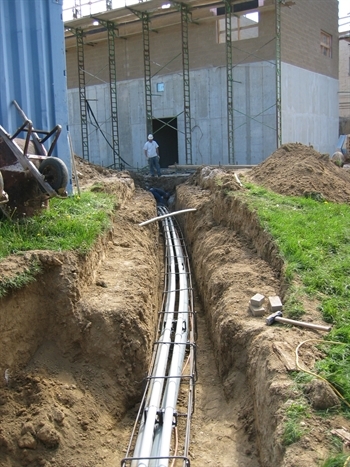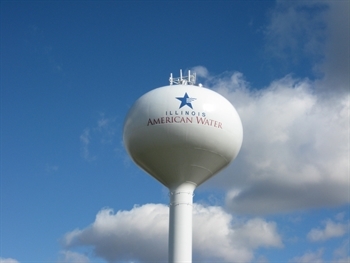
Courtesy Illinois American Water
 By Michael Smyth
By Michael Smyth - February 25, 2013
Experiencing Drought is a series of guest profiles by public works officials on the impacts of drought on northeastern Illinois communities. This is the fifth in the series, view other posts from the Experiencing Drought series. For more information, please contact Abby Crisostomo at acrisostomo@metroplanning.org.
Water Company: Illinois American Water
Service Districts: Chicago Metro, Interurban (Metro East), Streator
Water Sources: Lake Michigan, Mississippi River, Vermillion River
Issue: Addressing water supply needs throughout Illinois American Water service areas
Outcome: Full cost pricing that reflects the true cost of water service allows a water utility to make prudent infrastructure investment and ensure reliable water service, even during times of drought.
Overview

Illinois American Water has service areas throughout Illinois, but three districts in particular serve as examples of long-term investments.
Illinois American Water is the largest investor-owned water utility in Illinois providing service to over 1.2 million people daily. Our team of over 400 employees takes tremendous pride in being part of 127 Illinois communities. Daily, our team maintains approximately 4,100 miles of water main and 29,000 fire hydrants, while pumping an average of 115 million gallons a day (MGD) of water. When faced with the challenge of the historic drought conditions of 2012, our team of water professionals was ready for the job.
Illinois American Water’s service area stretches from South Beloit to Cairo and touches many communities in between including four large service districts of Chicago Metro, Peoria, Champaign-Urbana, and Interurban (Metro East). Given this vast geographic footprint, our team accesses several water sources in the management of your water supply. Our company’s Vision, “To be the trusted steward of your precious resource – water” is truly a passion of ours and one that was tested this past year.
Our company experienced many challenges considering the drought conditions. These challenges continue today with the near-historic low Mississippi River level in southern Illinois. Sources of water supply vary among our service areas inIllinois, presenting complex challenges. In our Chicago Metro District, almost all of our customers receive Lake Michigan water. Customers in the Streator District are served by the Vermillion River, while further south the Interurban District water source is the “Mighty Mississippi.”
Full Cost Pricing
A brief overview of the technical challenges in each case will follow, however in order to appreciate water supply issues, it is important to know about full cost pricing. As a regulated utility governed by the Illinois Commerce Commission, our company’s water rates reflect all of the costs to provide service to our customers, i.e. full cost pricing reflecting the true cost of water service. This includes investment necessary to maintain and upgrade critical water infrastructure needed to collect, treat and deliver water service to homes and businesses. This infrastructure includes water treatment facilities, water main, fire hydrants, pumps and meters.
Full cost pricing is endorsed by many, including MPC, the United States Environmental Protection Agency (EPA), and the Chicago Metropolitan Agency for Planning (CMAP). The transparency and pricing signals of full cost pricing are a critical element of water conservation. This is very important when considering the water utility industry is more capital intensive in nature than the gas and electric utilities combined. Over the next 20 years, the EPA estimates the investment need in Illinois for drinking water is $15.02 billion and $17.5 billion for wastewater systems. Across the United States the investment needs are in the hundreds of billions of dollars.
Fortunately for our customers, Illinois American Water has made the prudent infrastructure investment many communities have been unable to complete. This is largely due to our water rate structures, which reflect full cost pricing. Illustrated in the cases that follow, this concept of full cost pricing is vital to the investment and in turn improvements made in our systems. Many communities are unable to make the needed investment due to rates that are kept artificially low and do not reflect the true or full cost of water service. Proactive improvements enable our team to handle challenges like those presented by the recent historic drought conditions.
Illinois American Water – Streator District
In August 2011, our Streator District completed an approximately $5.5 million water treatment plant upgrade. The investment enhanced water quality and operational efficiencies while incorporating environmentally-focused technology. In addition to the technological improvements, a new filter and filter pump station were installed to address water quality needs.

Energy savings and improved water quality are just some of IAW's returns on investments.
IAW
The importance of these improvements is significant to the service we provide our customers each day. However, surface water like the Vermillion River, which supplies the Streator District, can be impacted severely by drought conditions. The improvements to the water treatment plant helped to mitigate the effects of this historic drought.
The environmentally-focused improvements made through this project included reducing river bank erosion, installing motion-sensor lighting at plant buildings, and upgrading the plant’s residual lagoon which enables residuals from the treatment process to be applied as a conditioner to area farmland more often.
The investment also included energy-saving technology through the installation of variable frequency drive (VFD) motors. According to David Clifton, Streator Operations superintendent, “VFD motors ensure motors operate based on current pumping demands. This saves on energy use and cost, reducing our environmental footprint, while benefiting our operations and customers.” Lastly, the project also increased reliability and security through the installation of new piping, control valves, and flow meters, structural improvements and security system upgrades. A backup generator also ensures reliability during emergency situations.
Our company didn’t make this important investment because we knew there would be a drought in 2012. However, we were well prepared for the situation because we did.
Illinois American Water – Interurban District
For most of us, we consider the drought conditions of last summer to be history, something that is behind us. We may have heard recently how low levels of the Mississippi River are having an adverse impact on barge traffic in Southern Illinois or further south from there. The impact on our national economy cannot be overstated. Indeed, for many residents of the state who rely on the Mississippi River as a source of water, the drought conditions are still an active problem.
Illinois American Water provides service to approximately 250,000 customers in the Interurban (Metro East) service area, a large group of communities across from St. Louis, Mo. Our company continues to monitor the Mississippi River and the declining water levels.
An investment of approximately $500,000 at the East St. Louis Water Treatment Plant included two floating barge units with auxiliary pumping equipment, which allows access to source water at a deeper level in the Mississippi River. Total capable flow from the units is about 52 million gallons per day. The construction allows for continued reliability without additional demand on existing plant operations. The floating design will ensure the equipment is stable throughout varying river level conditions. In addition, construction of a barrier wall protects vital equipment through the winter months.
Illinois American Water – Chicago Metro District
The previous cases help illustrate the benefit Chicago-area residents enjoy due to our proximity to Lake Michigan. While the drought of 2012 has certainly had lasting effects on our fellow downstate Illinois residents, most residents in the Chicago area are more concerned with increasing water rates than declining water levels in Lake Michigan. Is this the right perspective?
“Odd-even” outdoor watering in summer months is the norm and for most of us that really didn’t change last summer. There were stories in some communities that water usage was restricted further, however, this was the exception. For our Illinois American Water service areas in Chicago Metro, storage capacity and price signals prevented strain on our supply and the need for further restrictions at any point last summer.
As most of us know, the City of Chicago increased rates per 1,000 gallons of water by 25% in 2012, 15% in 2013, and will implement additional increases of 15% in 2014 and 2015. After 2015, rates will be adjusted based on the Consumer Price Index. While some ask why these increases are necessary, we need to understand that water is a precious resource. Consider the aforementioned EPA estimates of needed infrastructure investment in our water and wastewater systems and the fact that the water utility industry is more capital intensive in nature than gas and electric utilities combined. Lake Michigan water is not an unlimited resource; and infrastructure investment in our pumps, pipes and treatment facilities to protect this precious resource is vital.

IAW
Illinois American Water’s Chicago Metro District has made prudent infrastructure investment in our storage facilities, and this helped mitigate circumstances we experienced last summer. In addition, because we purchase Lake Michigan water from several suppliers, we participate in regional planning groups whenever possible. In fact, our company is taking part in a MPC/CMAP Water Policy Group discussing water resource planning for the region. We will continue to look at short- and long-term needs, new ways to manage power such as electricity that is needed to pump water, and improvements in construction techniques for water storage.
The true cost of water reflected in full cost pricing is an important concept to remember as water rates continue to be in the news. Rates that reflect the true cost of water promote sustainability, conservation and necessary infrastructure investment. These rate structures also present accurate pricing signals to help us understand the value of water. Whether we live in Streator, near St. Louis, or next to Lake Michigan, the drought of 2012 should help us remember one thing – the value of water, our precious resource.
Michael Smyth is a Senior Manager of Field Services and Production, responsible for the Chicago Metro District of Illinois American Water. He has a degree in Political Science from the University of Illinois at Chicago and a MBA from Saint Xavier University. He has been in the water and wastewater industry for 13 years.